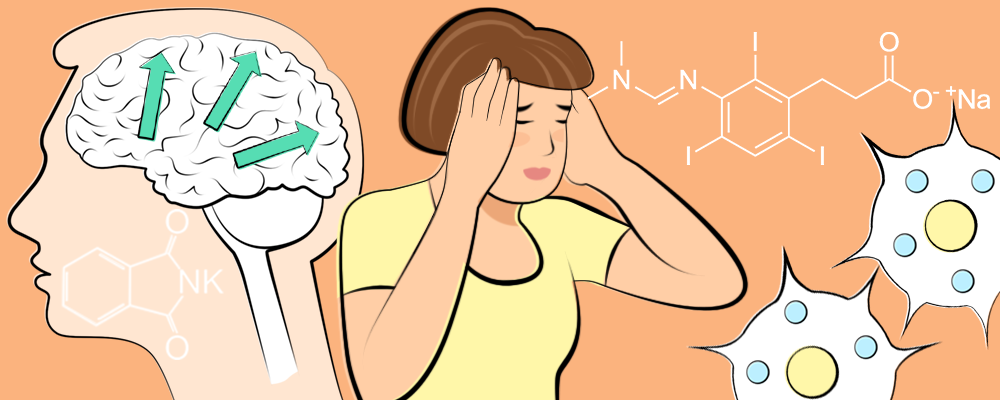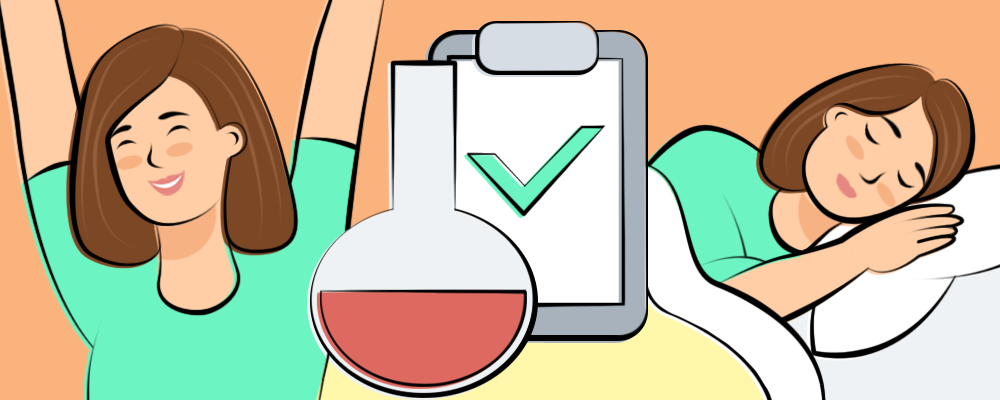Once you start to feel the symptoms of a migraine — headaches, nausea, or sensitivity to light and sound — you are likely to benefit from taking a pharmaceutical acute treatment.
Acute migraine treatments are taken as needed to stop a migraine attack or to reduce the severity of migraine symptoms.
In this way, they are different from preventative treatments — also known as prophylactic treatments — which are taken on a regular basis to prevent the onset of migraines and reduce their severity.
If you’re looking for more information about pharmaceutical acute treatment, keep reading. In this article we’ll break down the most important benefits and drawbacks associated with this type of treatment — giving you all the information you need to decide what’s best for you.
When to use pharmaceutical acute medications
Pharmaceutical acute treatments are usually best taken early in the course of migraine — e.g. when your symptoms first set in — as this will make them more effective. However, specific recommendations may vary with different medications, so always read the label.
And whilst you may find welcome relief from these treatments, you should be careful not to use them too often. If you find that you need them more than twice a week, you may be at risk of developing medication overuse headache — also known as a ‘rebound headache’. This means that the medication will make you feel worse instead of better, and you will have to stop using it.
Let’s quickly explain what an overuse, or rebound, headache is and what causes it…
Regular, ongoing use of acute medications can affect receptors in your brain, influencing the way you process pain. The result of this can be a continuous cycle of headaches, known as medication overuse or rebound headache. Not only does that sound very unpleasant, it’s also quite dangerous.
Thankfully, medication overuse headache can be treated by cutting out the overused medication — although the process of weaning yourself off a migraine treatment may cause a little more discomfort in the short term. As always, speak to your doctor if you think you are experiencing rebound headache. And together the two of you can work out the best course of action.
Different types of acute pharmaceutical treatments
There are a variety of acute pharmaceutical treatments available, most of which target headache pain. These medications may also help with other symptoms such as nausea or light and sound sensitivity.
We’ll begin by looking at readily available, over-the-counter treatments. But we’ll also take a look at treatments that may be prescribed by your doctor.
To round things up, we’ll also touch on a type of acute medication targeted specifically at nausea — these are called antiemetics and will be discussed towards the end of this guide.
Over-the-counter painkillers
Over-the-counter painkillers — such as aspirin, acetaminophen (also known as paracetamol) and ibuprofen tablets — can be very effective in treating migraine headaches. These pills work especially well if they are taken as soon as you feel a headache coming on.
But how much clinical research has gone into OTC migraine treatments?
Paracetamol has been widely studied, and has shown to reduce headaches from severe or moderate pain to none in around 20% of people tested. A good result, but not great.
Ibuprofen performs better.. A review of Ibuprofen studies found that roughly 50% of people using the drug will have their pain reduced to mild or better. And similar results were found with the use of aspirin. For the 50%, this is great news! After all, over the counter medication is easy to come by.
But what about the other 50%? These migraine sufferers often need to take prescribed medications in order to experience relief. These can include triptans, ergotamine, or prescription Non-Steroidal Anti-Inflammatory Drugs (NSAIDs). We discuss these pharmaceutical treatments in the coming sections.
Before we move on, it’s important to note that all medication comes with the risk of side effects. For this reason, you should always read — and follow — the instructions and recommendations in the box. For extra safety and certainty, speak to your doctor before starting a new medication and be mindful of potential interactions with other medications (migraine-related or not).
Triptans
Triptans are a group of drugs also known as 5HT1-receptor agonists. They work by acting on serotonin receptors in the brain. Unlike over-the-counter medications, triptans are only available with a prescription and specifically meant for the treatment of migraine.
Triptans used in migraine medication include almotriptan, eletriptan, frovatriptan, naratriptan, rizatriptan, sumatriptan, and zolmitriptan. They are available in the form of tablets, nasal sprays, and injections.
Despite the wide variety of applications, there are times when the first dose of a triptan doesn’t produce the desired effect. In this case, you can repeat the dose after two hours. And if your pain is still severe, triptans can be combined with NSAIDs to increase their effectiveness (more on NSAIDs later).
Before we dive into the side effects of triptans, it’s worth pointing out that this medication is very expensive (compared to OTC treatments), costing up to 50 dollars per pill. What’s more, it’s only really safe to take triptans nine times in a month, meaning many patients wait until late in their migraine attack to treat the pain with triptans, preferring to try other solutions first. And whilst that is solid logic (financially, at least) this can further reduce the efficacy of the triptans — essentially, you don’t get the pain relief you need, but you may still suffer the side effects…
It’s very common to get side effects when using triptans — far more common than with OTC medications. These side effects vary between different individual medications but may include dizziness, chest pain, and fatigue or drowsiness. But for the most part, as long as you’ve spoken to your doctor, you should be absolutely fine with triptans — if you take them responsibly.
That being said, some people will be considered higher risk when taking triptans, especially if they are already on other medication. Put simply: there are a number of medications that aren’t safe to take with triptans, and triptans are not suitable for people with some pre-existing medical conditions.
For example, you should exercise specific caution if you are also using antidepressants such as SSRIs (Selective serotonin reuptake inhibitors), including Fluoxetine (Prozac) and Citalopram (Celexa).
Triptans also should not be used by people with a history of heart disease, high blood pressure, high cholesterol, angina, vascular disease, liver function impairment, stroke or diabetes. No matter your medical history, your doctor will want to review your overall health before prescribing triptans — just to make sure it’s safe for you to take them.
Lastly, it’s important that you know how to take triptans properly if you’re experiencing migraine with aura. A migraine with aura is when your headache is preceded by a series of sensory disturbances — spotty vision, flashes of light, blind spots, and other temporary vision impairments.
If you use triptans to treat your migraine with aura, do not take them before the headache has set in. If taken during the aura phase, the triptans’ effectiveness may be compromised.
Ergotamine
Ergotamine is an acute medication for migraine and can also be used as a prophylaxis for cluster headaches. Like the triptans, ergotamine has an impact on the nervous system by impacting serotonin receptors.
Ergotamine is available in the form of tablets, sublingual tablets (which you place under your tongue and are absorbed,) or suppositories. Whichever you choose is largely down to personal preference — some of us just don’t get on well with swallowing pills, do we?
Ergotamine can come with side effects like circulatory problems and a change in heart rate or blood pressure. So you should avoid this medication if you have a history of heart disease or other heart and/or blood pressure issues. Because of these side effects ergotamine is also prescribed very rarely these days.
NSAIDs
Over-the-counter NSAIDs such as aspirin and ibuprofen are easily accessible. Whereas other NSAIDs — naproxen, tolfenamic acid, diclofenac potassium, erc. — will require a prescription from your doctor.
With the NSAIDs family, there are a number of treatments which will serve certain individual needs. For example, if your migraines tend to come with nausea and vomiting, then you may find it useful to switch to prescribed diclofenac sodium suppositories. Or, if you suffer from menstrual migraines, paired with extreme menstrual cramping and/or heavy periods, mefenamic acid is an NSAID worth exploring.
NSAIDs are popular as they tend to be less expensive than triptans. What’s more, they may also be less likely to result in rebound headaches than other pharmaceutical acute treatments.
But before you get too excited, it’s worth absorbing the potential side effects…
Heartburn is a very common NSAID side effect, caused by stomach acid rising up into the esophagus and creating a burning sensation in the chest. NSAIDs can also cause diarrhea (which is perhaps even less pleasant!). And whilst you don’t need to worry so much about overuse headache, regular and frequent use of NSAIDs can in fact damage your kidneys and liver — so it’s best to keep track of your usage and not overdo it.
Lastly, NSAIDs can irritate the lining of your stomach, making them unsuitable for those who suffer from gastrointestinal conditions such as gastroesophageal reflux (GERD), peptic ulcers, or irritable bowel syndrome.
Antiemetics
Antiemetics are meant to treat the nausea that some people experience in conjunction with their migraines. You may have heard of them as metoclopramide hydrochloride or prochlorperazine.
These antiemetics can be taken by mouth or given via injection and, while their primary function is to treat your nausea, they may help alleviate headaches at the same time.
Metoclopramide hydrochloride is a risky medication as its side effects involve your nervous system — not something you want to mess with! Prochlorperazine is a little less dangerous, but it can still cause some unwelcome side effects such as bad dreams and anxiety — two things likely to make your migraines worse.
In short: proceed with caution when using these nausea-fighting drugs, and always speak to your doctor first.
In summary...
As you can see, there’s a wide range of pharmaceutical options available to treat the acute symptoms of migraine. However, these treatments all have several potential side effects and must all be used carefully.
Seek advice from your doctor if you have any doubts about whether a medication is right for you. And if you find that you need to use acute pharmaceutical treatments more than twice a week, you will likely need to seek other methods of managing your symptoms. Have you considered home remedies, for example?




